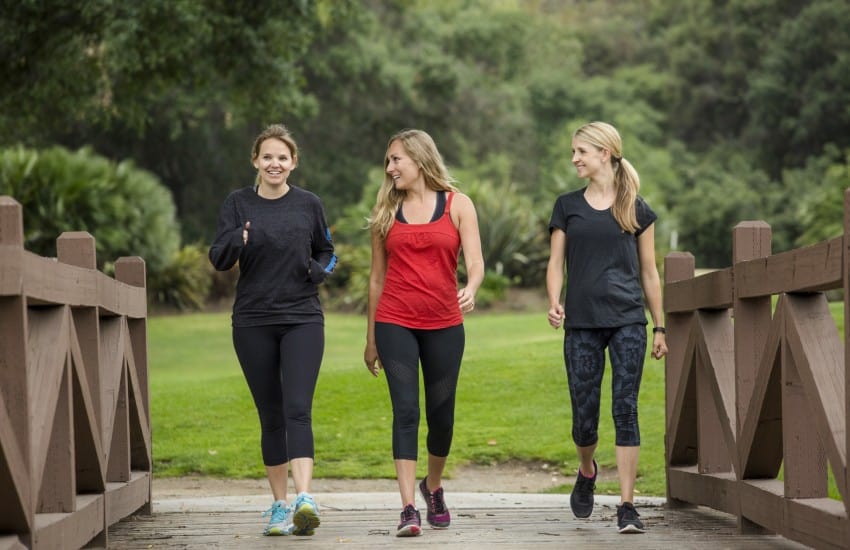Walking is a super-powered exercise activity, here’s why

Boosting your energy for a busy day ahead … using walking as a break from the home office … spending time with family or to get some vitamin D—all reasons why Queenslanders take to the streets.
Walking is a popular activity for many, and the good news is, keeping obesity and chronic diseases at bay can be as simple as putting one foot in front of the other. But what makes walking such an effective physical activity?
Research from the Heart Foundation shows walking at a brisk pace for just 30 minutes every day can lower the risk of heart disease, stroke and diabetes by 30% to 40%. An incredible result for such an enjoyable low-effort, low-risk physical activity.
The health and wellbeing benefits are many and varied, proving walking really can walk the talk.

Walking is great for helping you manage your weight
Getting yourself into the habit of taking a brisk walk each day can do wonders for your waistline when combined with other healthy activities.
Australia’s Physical Activity & Sedentary Behaviour Guidelines recommend adults 18-64 years to be active on most days and to accumulate 150 to 300 minutes of moderate-intensity physical activity each week. A good example of moderate-intensity activity is brisk walking, that is at a pace where you are able to talk comfortably but not sing. Walking at a fast pace for 30 minutes can burn up to 315 kilojoules (75 cal) each day you do it—and of course the faster and further you walk the more kilojoules you will burn. This is significant, considering the average person eats and drinks 8700 kilojoules a day ( Better Health)
But if you’re new to walking for exercise or are out of the habit, you’ll want to ease yourself into it. Find a local walking group and join their regular walks, or head to the Heart Foundation’s walking website and check out the hints and tips. It even has a handy tool that helps you find community walking groups near you.
Walking can help lower blood pressure and cholesterol
Many Queenslanders have problems associated with blood pressure and cholesterol. The Australian Diabetes, Obesity and Lifestyle Study (AusDiab) estimate that a quarter of Queenslanders have hypertension (high blood pressure) and almost one half of adult Queenslanders have high blood cholesterol.
But adding a brisk walk to your every day routine can help.
An observational study by the University of California in San Francisco found that for every 1,000 steps a person takes each day, their systolic blood pressure was about 0.45 points lower. Systolic blood pressure is the top number in the blood pressure equation, and measures the pressure of the heart when it contracts.
So someone aiming for 10,000 steps a day—about 1.5 hours of walking daily—could lower their systolic blood pressure by 2.25 points. A great result, but be sure to consult your doctor first with ideas about managing your blood pressure.
Your doctor may have also explained to you about the three main types of cholesterol: triglycerides, HDL and LDL. According to The Cleveland Clinic, walking at a solid pace most days of the week will help increase the body’s production of good cholesterol (HDL) and lower the body’s absorption of triglycerides. Lowering bad cholesterol (LDL) isn’t generally affected by exercise, and requires a healthy diet and weight loss.
Happier people walk more
Got a smile on your dial? Maybe you’re a keen walker already.
Experts at mental health charity the Mindshift Foundation say walking 30 minutes a day can help reduce your stress levels, alleviate anxiety, boost the production of the brain’s happy chemicals such as endorphins and help you to relax. That’s backed up by a UK study that showed people who did regular moderate physical activity such as walking were 30% less likely to become depressed.
Walking has also shown strong social and wellbeing benefits for the elderly. According to a survey by the health department in Victoria, people aged over 55 are most likely to use walking as their main form of exercise—helping to foster social connections and improve balance and coordination. That means better mental health outcomes, fewer trips to health services with fractures or injuries from falls, and better prevention of osteoarthritis and osteoporosis.
Walking is shown to lower the risk of some cancers
The Cancer Council of Australia has long spruiked the benefits of consistent physical activity in helping to reduce the risk of getting certain cancers, including bowel cancer and some breast cancers.
If you’re already hitting the pavement to shed some weight or lower your blood pressure, you’ll be glad to know that the council says adding just an hour of brisk walking—or even mowing the lawn at a decent pace—can do wonders in reducing the risks of getting some cancers.
Walking is good for the environment
Think cleaner air and less traffic—walking has some serious environmental credibility. By reducing car trips and cars on the road, increasing our amount of walking helps to reduce noise pollution, emissions, traffic congestion, and reliance on fuel.
Looking for ways to get out and walk your way to a healthier life? Health & Wellbeing Queensland supports 10,000 Steps in conjunction with Central Queensland University. 10,000 Steps aims to increase the day-to-day activity of Australians by encouraging the use of step-counting pedometers or activity trackers to accumulate ‘incidental’ physical activity as part of everyday living. 10,000 Steps initiative includes a supporting program and free resources. More information is available on the 1`0,000 Steps website.


